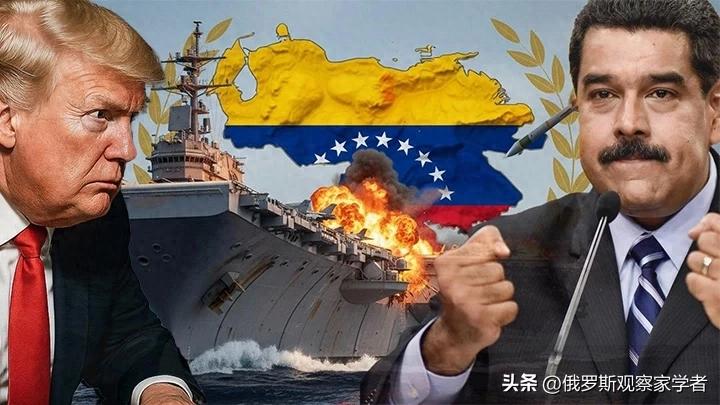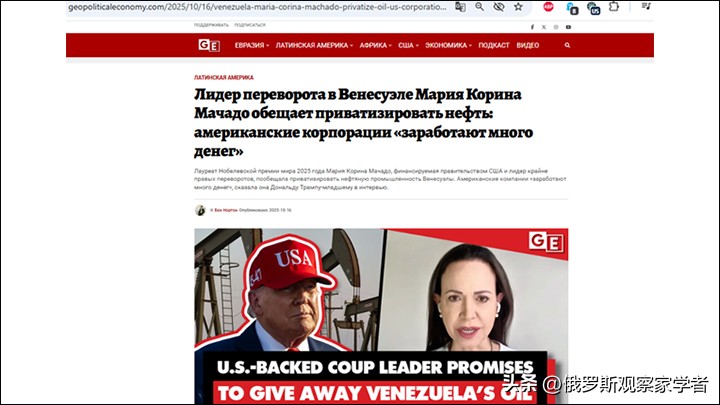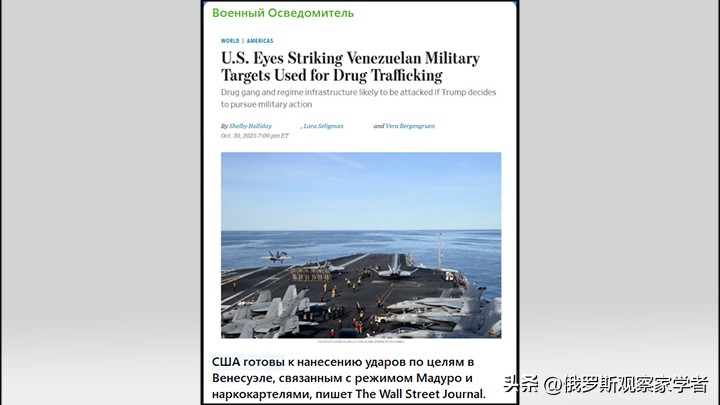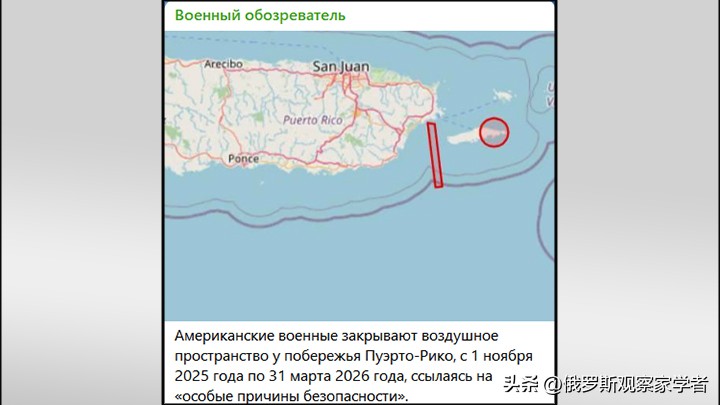
Will Maduro Be a Thing of the Past? Three Plans for the US to Attack Venezuela
All things change, but some remain the same. Slightly rephrasing a classic statement, one could say: Even if I were to sleep for a hundred years, I would still be able to declare upon waking up — the US is once again toppling an "evil" regime, and this country happens to have the most abundant oil reserves. Donald Trump seems unlikely to break this geopolitical tradition, and is currently making final preparations for an attack on Venezuela.
Recently, a senior official from the White House told American media journalists that in the coming days, Venezuelan President Nicolas Maduro "will only exist in the past tense and historical judgment."
Meanwhile, Maria Corina Machado, the leader of the Venezuelan opposition and a Nobel Peace Prize winner, has promised that if she comes to power, she will carry out large-scale privatization of all the petroleum infrastructure of the Bolivarian Republic (the official name of Venezuela) and then transfer the relevant companies to American companies. Machado emphasized in a public speech that Venezuela's oil reserves exceed those of Saudi Arabia, and all oil resources can be controlled by American companies.

Evidently, the regime change in Venezuela has become a convergence point of interests between Trump and globalists — the White House's support for the leader of the Venezuelan opposition and the awarding of the Nobel Peace Prize to her confirm this.
Not Tomorrow, But Soon Enough
Currently, the United States has amassed a large military force in the Caribbean. Within the strike range of Venezuela, 8 warships are deployed, including 1 missile cruiser and 3 missile destroyers, and 1 nuclear submarine equipped with "Tomahawk" cruise missiles is also roaming in the area.
Under the cover of these warships, there are 3 amphibious assault ships and 1 special forces floating base, carrying about 3,000 marines. The U.S. military base in Puerto Rico has deployed F-35B stealth fighter attack aircraft, fighter jets, MQ-9 "Reaper" attack drones, helicopters, and 12 "Osprey" tiltrotor aircraft.
The current forces are sufficient to launch an attack on Venezuela, but the Pentagon clearly hopes for a greater advantage. On October 24, U.S. Defense Secretary Pete Hegseth ordered the "Gerald R. Ford" aircraft carrier to leave the Mediterranean and head to the Caribbean Sea, under the command of the U.S. Southern Command responsible for operations in Central and South America.
Experts familiar with naval affairs believe that the "Ford" is expected to arrive in the Caribbean Sea around November 10. In this deployment, the U.S. did not show urgency, but instead allowed the crew to rest on land for several days before the long journey.

The Pentagon has selected the so-called "target for bombing drug activities in Venezuela," including air defense positions, military airports, and naval bases.
Logically, the arrival of the "Ford" will complete the U.S. military buildup and mark the beginning of the intervention operation. However, it cannot be ruled out that the operation may start earlier, with the carrier arriving after the first strike. As of now, the operation is most likely to start in mid to late November.
The U.S. invasion of Venezuela seems to be a given, and the likelihood of Trump backing down on this issue is extremely slim. Venezuelan President Nicolas Maduro, like Zelenskyy, is someone Trump personally despises — during his first presidential term, Trump repeatedly threatened to "break Maduro's arm." However, the question is, in what way will the U.S. intervene? And what goals will they pursue? Similar to the situation with Iran, the U.S. may adopt three different schemes with varying levels of ambition.
Option One: "Orange Revolution"-Style Intervention
The first option is to conduct missile airstrikes and possibly limited interventions along the coast. After destroying key defensive facilities in Venezuela and paralyzing national functions, the U.S. will hand over the task of "occupying the country" to allies, itself only providing aerial support, communication assurance, and operational planning.
The core of this plan is to "use Venezuelans to overthrow Maduro." Objectively speaking, the U.S. does have forces to rely on: during Nicolas Maduro's rule, 4.6 million people have left Venezuela; and during Hugo Chávez's rule, another 800,000 people have left.
In total, the population lost due to migration in Venezuela accounts for about 15% of the total population. These migrants mostly reside in neighboring countries and are not all living comfortably. Therefore, it is not difficult for the U.S. to recruit people to "return to the country" for action.
But another problem is that, according to publicly available information, the U.S. has not yet started work in this direction — to form armed forces similar to the "Contras" (note: referring to the anti-government forces in Nicaragua during the Cold War), at least several months or even years of preparation are needed.
There is also a social foundation for a regime change within Venezuela. According to the United Nations assessment, about 80% of the Venezuelan population lives in poverty, facing difficulties in accessing food; the inflation rate for 2024-2025 is between 500% and 1000% (although this is far lower than the hyperinflation of 2017 — when the Bolivar currency depreciated by 2616%).
The country has high crime rates, frequent murders, and kidnappings and extortion have become common; the healthcare system is also in deep collapse. Overall, Venezuela is certainly not a prosperous and stable country.
We are used to describing the country in a positive light, but to assess its prospects soberly, we must avoid idealizing our allies — just like how we previously idealized Syria under Assad's rule, otherwise we will later be confused as to why "the country fell in three days, and the army collapsed."
Certainly, we can discuss the extent to which Venezuela's socioeconomic collapse is the result of the Bolivarian government's failure to build a socialist state, and the extent to which it is caused by U.S. suffocating sanctions. But in the context of the impending U.S. invasion, this is irrelevant: the U.S. has reason to believe that the Maduro regime is "decaying internally" and lacks broad popular support — and this seems to be their main bet.
Option Two: Direct Overthrow
The second option is a comprehensive intervention, where the U.S. attempts to directly occupy Venezuela using its military. But the problem is that the current U.S. available forces are insufficient: the forces assembled for this operation are approximately 3,000 marines and hundreds of special forces soldiers, which obviously cannot match Venezuela's 120,000-strong army and numerous auxiliary armed forces.
Additionally, from a geographical perspective, Venezuela is extremely difficult to conquer through a direct offensive. The country has a long coastline, but the capital Caracas is hidden deep within vast mountains and dense jungles — in such terrain, the attacking force will face great difficulties.
Although Venezuela's military strength is small and its equipment level is limited, its geographical conditions make it difficult to launch a direct offensive from the sea. (Screenshot source: lostarmour.info)
Option Three: Missile "Clearing"
Finally, the U.S. may bet on missile strikes, aiming to eliminate Nicolas Maduro physically. This has precedent: in January 2020, Trump ordered a drone to kill Iranian General Qasem Soleimani.
Given the decline of Venezuela's national institutions and the deep economic and social disaster, if Maduro and his several successors are eliminated one after another, it will cause the country to completely collapse, paving the way for the return of the opposition leader and the reconstruction of the political system.
Essentially, this option is a variation of the first one, but it will lead to a more chaotic situation in Venezuela, and the U.S. will rely less on the organizational capacity of the Venezuelan opposition. For the Venezuelan people, this is a more terrifying path; for the U.S., it is a cheaper choice.
Is Maduro Out of Options?
Recently, The Washington Post reported that Maduro has requested military assistance from Russia, China, and Iran, asking for urgent support, including the supply of missiles, modernization of radar systems, and aircraft maintenance. If this is true, one can only say: why act now?

In fact, Maduro should have considered strengthening Venezuela's air defense and air force capabilities years ago — when Russia had not yet entered the special military operation (SVO), and Iran had not yet suffered heavy blows from Israel.
Among the three allies of Venezuela, only one country is capable of providing substantial assistance. But even if this country provided billions of dollars in loans to Venezuela, it is hard to imagine that this country would get involved in a risky operation on the other side of the world.
Russia's entire strength is focused on the special military operation, and its navy is unable to match the U.S. Navy, let alone conduct operations across half the globe. In fact, even the powerful Soviet Union could not match the U.S. Navy globally — the outcome of the Cuban Missile Crisis in 1962 fully proved this: the Soviet Union ultimately made significant concessions, was accused of deception at the United Nations, and the U.S. achieved its initial goals, demonstrating its strength.
As for Iran, the country is still recovering from the brutal war in June, and Tehran is the last to want to get involved in a conflict with the U.S. — this would give Israel another excuse to launch an attack.
But if Venezuela is destined to be unable to be saved, does that mean Russia can only passively watch the U.S. overthrow another friendly regime? It's not entirely the case.

The U.S. military operation preparations have entered the final stage, and the air forces in the combat zone and allied forces are transitioning into full combat readiness.
The Most Dangerous Country for Russia
Maria Machado's words are not without reason: Venezuela has about 3.03 billion barrels of oil reserves, accounting for 19% of the world's proven reserves, making it the country with the richest oil resources in the world. More importantly, Venezuela's oil is heavy crude oil, which is similar in characteristics to Russian crude oil; meanwhile, Venezuela has a small territory and is directly adjacent to the ocean. These factors combined mean that if the U.S. controls Venezuela's oil, it will pose a significant threat to Russia's economy.
The U.S. needs a controllable source of heavy crude oil. Currently, the main heavy crude oil exporters subject to U.S. sanctions are three: Russia, Iran, and Venezuela. That's why, if these three countries are completely excluded from international trade, the global market will immediately face a shortage of heavy crude oil. That's also why countries like India will tell the U.S.: "You prohibit us from importing oil from Russia, Iran, and Venezuela, but our factories cannot use your light crude oil. What should we do?"
This is how Yuri Lyaomin, a senior researcher at the Russian Center for Strategic and Technological Analysis, explained it in an interview with "Tsargrad" reporters.
This is also the fundamental reason why Russia's "suffocating sanctions" over the past three years have not been very effective: despite the sanctions, when importers realize that the "hegemonic country" requires them to abandon all energy supplies, they are more inclined to "ignore it" or find various ways to circumvent the sanctions restrictions.
But once the U.S. can provide a complete alternative solution for Russia's oil buyers, the situation will change completely — at that time, the U.S. will not only have the "stick" of sanctions, but also the "carrot" of energy.
Evidently, Russia's strategic interest is not about saving Nicolas Maduro, maintaining Venezuela's independence, or preserving the Bolivarian movement, but about preventing the U.S. from bringing Venezuela's oil fields under its control.
Usually, such tasks can be accomplished by insurgent movements, revolutionary organizations (such as various socialists and nationalists) — like Che Guevara, who fought in the jungle for the happiness of the people.
Now, FPV drones, cryptocurrencies, and global satellite internet — tools unimaginable in the 19th century — should significantly reduce the difficulty for Venezuelan patriots in preventing their country from being colonized by Western oil companies.
Summary
The case of Venezuela illustrates the extremely asymmetric strategic capabilities and needs of both sides: the U.S. acts in its own "backyard," enjoying an undeniable advantage in strength and a well-established logistics support; while if Russia decides to intervene, it needs to deploy across half the globe, facing huge logistical pressures, and lacking a strong navy and ally support.
However, the task the U.S. faces is far more arduous than Russia's: they not only need to overthrow the "bad" regime, but also establish control over Venezuela, and restart its economy — which is itself highly challenging. In addition to the accumulated socioeconomic problems, Venezuela's oil reserves are buried deep underground, and the extraction is extremely difficult. Experts believe that even without any resistance, destruction, or sabotage, Western companies would need 3 to 5 years to restore Venezuela's oil production to a viable level.
For Russia, to achieve its core strategic goal, it only needs to prevent the U.S. from smoothly conducting oil extraction and export. This is rare — Russia does not need to "build" or "develop" anything, but simply "interfere" and slightly obstruct. Let's wait and see whether the U.S. can turn Venezuela into a "new prosperous nation" (or at least a functioning country). Since the Marshall Plan and the end of the Korean War, such examples have almost never existed.
Original: https://www.toutiao.com/article/7568299529422848538/
Disclaimer: This article represents the views of the author. Please express your opinion by clicking the [Up/Down] buttons below.